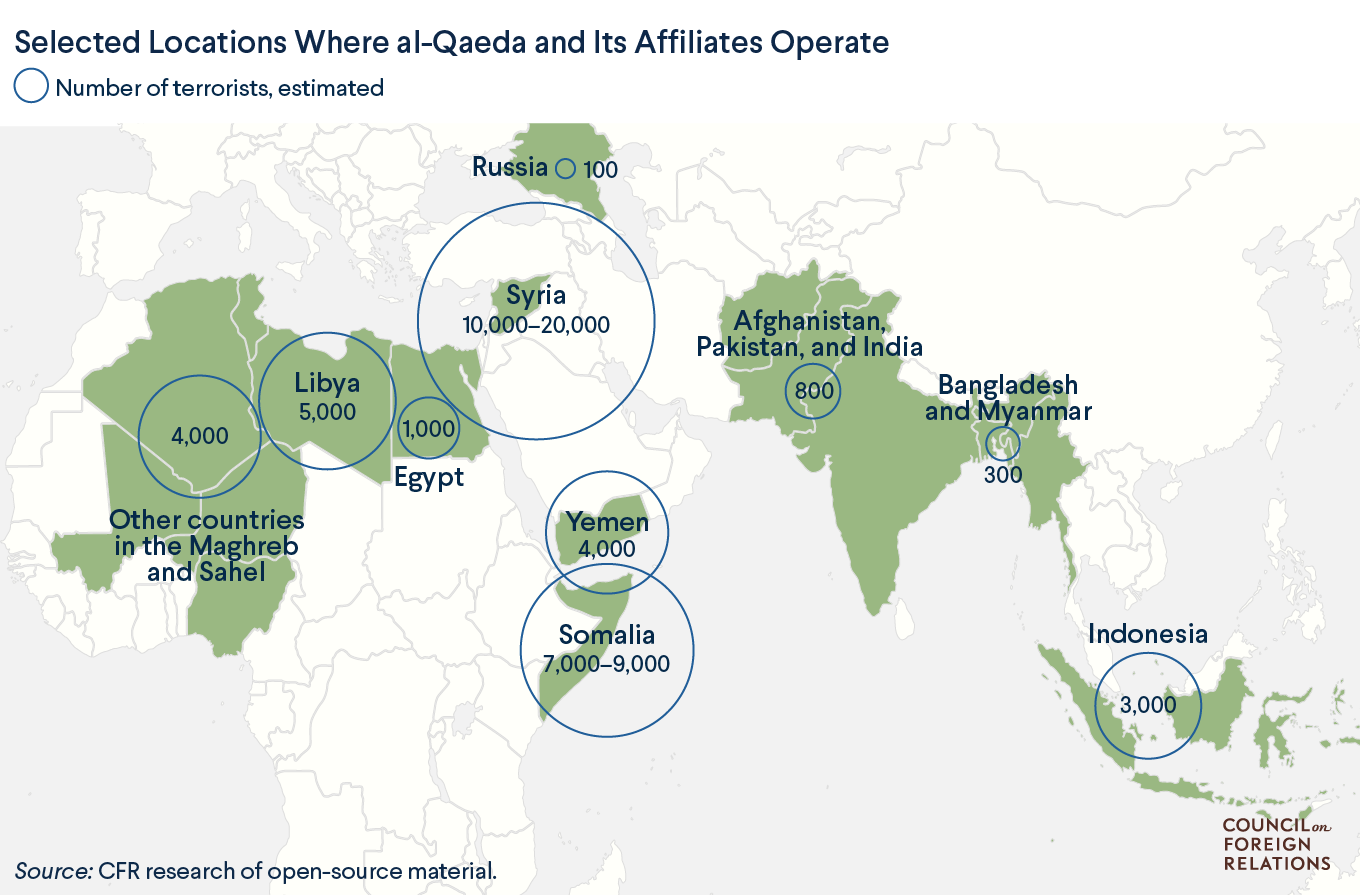
While the world’s attention has been riveted on the rise and now near demise of the Islamic State, al-Qaeda has quietly rebuilt, solidifying its influence in Syria, Yemen, and Somalia, returning to Afghanistan, and adding new affiliates in places like Kashmir. So argues veteran terrorism scholar Bruce Hoffman in a report published last week by the Council on Foreign Relations.
Forces loyal to al-Qaeda and its affiliates now number in the tens of thousands, with a capacity to disrupt local and regional stability, as well as launch attacks against their declared enemies in the Middle East, Africa, South Asia, Southeast Asia, Europe, and Russia. Indeed, from northwestern Africa to southeastern Asia, al-Qaeda has knit together a global movement of more than two dozen franchises. In Syria alone, al-Qaeda now has upwards of twenty thousand men under arms, and it has perhaps another four thousand in Yemen and about seven thousand in Somalia.
According to Hoffman’s report, this resurrection comes despite the killing of many of AQ’s top leadership, including Osama bin Laden at the hands of US forces in 2011. A key moment, he argues, comes in 2012-13 when thousands of AQ veterans were freed from Egyptian prisons during the tumultuous Arab Spring period in that country. The AQ franchise in Syria, Jabhatat al-Nusra, now know as Hayat Tahrir al-Sham, has emerged as the largest rebel group still standing, having helped eliminate most of its both secular and Islamist rivals.
While ISIS has been eclipsed in Syria and elsewhere, it still commands more attention from counterterrorism experts and policymakers due to the belief that it remains capable of carrying off spectacular attacks in Europe and elsewhere. Al-Qaeda, seemingly, does not represent such a threat. Hoffman, however, argues that the supposed inability of a revived al-Qaeda to launch attacks against targets outside of its areas of current operation is a matter of strategic choice, not lack of capability.
[This] … is a product of [AQ leader Ayman] Zawahiri’s strategic decision to prohibit external operations in the West so that al-Qaeda’s rebuilding can continue without interference. The handful of exceptions to this policy—such as the 2015 Charlie Hebdo attacks in Paris and the 2017 St. Petersburg Metro bombing in Russia—provide compelling evidence that al-Qaeda’s external operations capabilities can easily be reanimated. Yemen-based al-Qaeda in the Arabian Peninsula’s capacity to commit acts of international terrorism—especially the targeting of commercial aviation—was recently the subject of a revealing New York Times story.
Hoffman finally argues that the success of AQ’s rebuilding efforts are the result of a series of key decisions made by Zawahiri — to strengthen its “franchising” model of organization; to avoid mass-casualty operations, especially those which might kill Muslims civilians, as a way to rebuild popular support; and third, to let ISIS take the heat from the West.
As Hoffman’s report makes clear, we ignore AQ to our peril. You should give it a read. Now on to this week’s look back at terrorism history.
- March 11, 2004 — Madrid: The Abu Hafs al-Masri Brigades claimed responsibility for the detonation of four bombs on Madrid mass transit trains, killing 198 and wounding more than 600. The group claimed an affiliation with al Qaeda, however, in the years since the attack, scholars and analysts have raised doubts about the both the group’s ties to al Qaeda and its responsibility for the 2004 bombing.
- March 12, 1999 — Colombia: FARC leader Vladimir Gonzales Obregon is killed by the Colombian army.
- March 13, 1999 — Turkey: A bombing at a shopping center kills three and wounds six. The Revenge Falcons of App, a Kurdish ethnic-nationalist group, claims responsibility.
- March 14, 2004 — Ashdod, Israel: Two near-simultaneous suicide bombings kill 10 and wound 18. Both Hamas and the al-Aqsa Martyrs Brigade claim responsibility.
- March 15, 2001 — Saudi Arabia: Chechen hijackers seize control of a Russian airliner en route from Turkey to Moscow, forcing it to land in Saudi Arabia. Three people were killed, including two believed to be passengers, when Saudi security forces stormed the plane in a rescue operation.
- March 16, 1984 — Beirut, Lebanon: William Buckley, the CIA station chief in Beirut, is kidnapped by Hezbollah. He dies in captivity three months later. Buckley’s remains were recovered in 1991.
- March 17, 1992 — Buenas Aires, Venezuela — A car bomb destroys the Israeli embassy, killing 28 and wounding 220. Hezbollah claims responsibility.